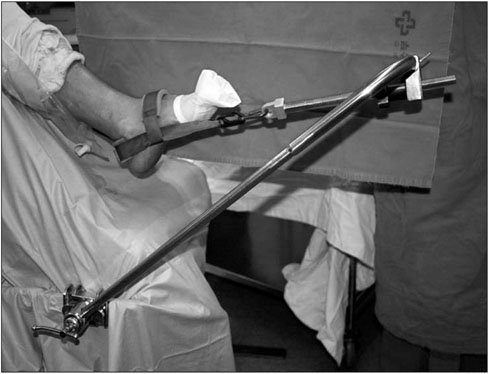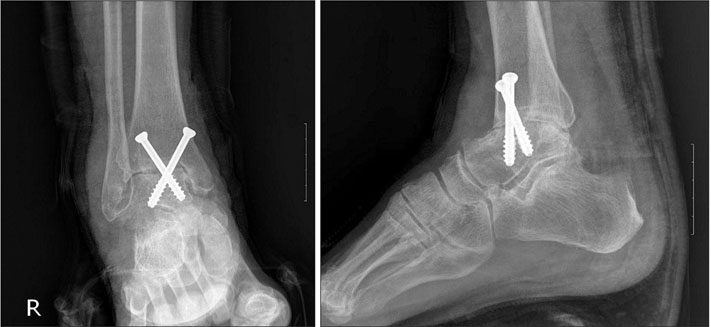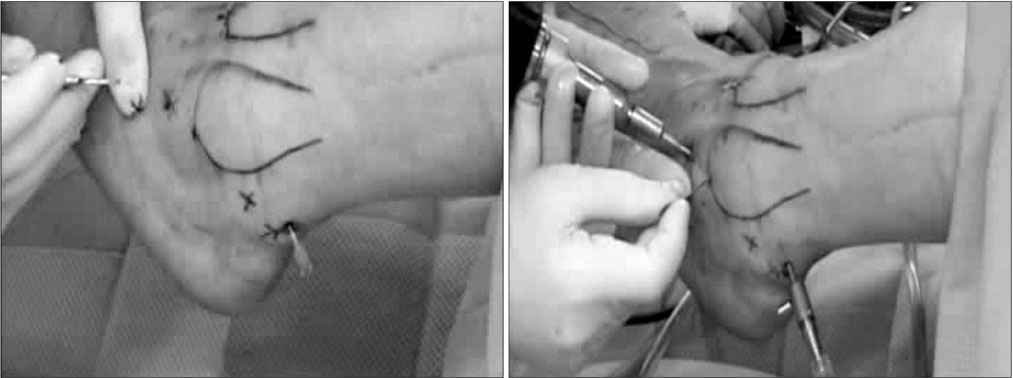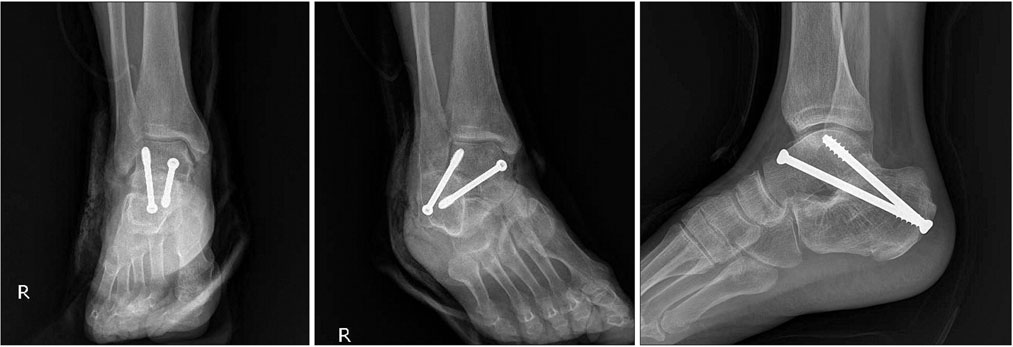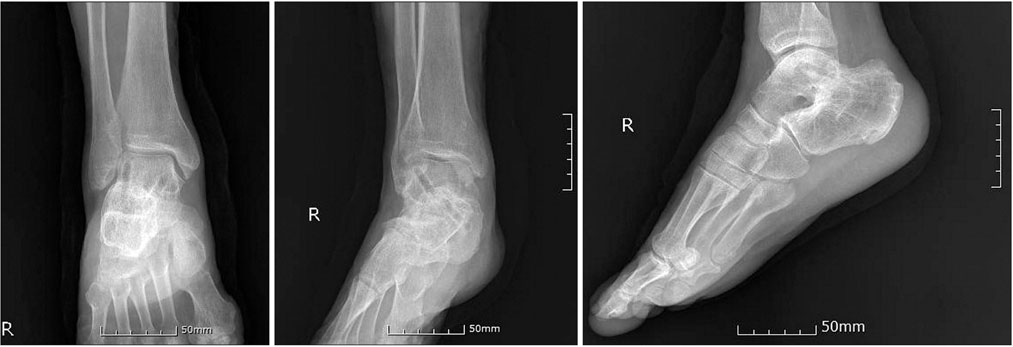J Korean Orthop Assoc.
2018 Apr;53(2):112-120. 10.4055/jkoa.2018.53.2.112.
Arthroscopy Techniques in Foot and Ankle Field: Arthroscopic Ankle and Subtalar Fusion
- Affiliations
-
- 1Department of Orthopedic Surgery, Busan Paik Hospital, Inje University College of Medicine, Busan, Korea. ortho1@hanmail.net
- KMID: 2410058
- DOI: http://doi.org/10.4055/jkoa.2018.53.2.112
Abstract
- For the arthroscopic fusion procedure, the development of arthroscopic techniques of joint preparation for fusion have made arthroscopic ankle arthrodesis popular, and foot and ankle surgeons also have gained considerable experience in arthroscopic techniques. Arthroscopic techniques offer minimized soft tissue disruption, lower morbidity and mortality, faster recovery, and shorter hospital stay and time to fusion. In addition, they may reduce the risk of wound complications for patients with a poor soft tissue envelope or relevant co-morbidities.
Keyword
MeSH Terms
Figure
Reference
-
1. Grimes CA, Mungle CS, Zeng ZF, et al. Wireless magnetoelastic resonance sensors: a critical review. Sensors. 2002; 2:294–313.
Article2. O'Leary Z. The essential guide to doing research. . London: Sage;2004.3. Townshend D, Di Silvestro M, Krause F, et al. Arthroscopic versus open ankle arthrodesis: a multicenter comparative case series. J Bone Joint Surg Am. 2013; 95:98–102.
Article4. Myerson MS, Quill G. Ankle arthrodesis. A comparison of an arthroscopic and an open method of treatment. Clin Orthop Relat Res. 1991; 268:84–95.5. Michael JM, Golshani A, Gargac S, Goswami T. Biomechanics of the ankle joint and clinical outcomes of total ankle replacement. J Mech Behav Biomed Mater. 2008; 1:276–294.
Article6. Nielsen KK, Linde F, Jensen NC. The outcome of arthroscopic and open surgery ankle arthrodesis: a comparative retrospective study on 107 patients. Foot Ankle Surg. 2008; 14:153–157.7. Gougoulias NE, Agathgelidis FG, Parsons SW. Arthroscopic ankle arthrodesis. Foot Ankle Int. 2007; 28:695–706.
Article8. Dannawi Z, Nawabi DH, Patel A, Leong JJH, Moore DJ. Arthroscopic ankle arthrodesis: are results reproducible irrespective of pre-operative deformity? Foot Ankle Surg. 2011; 17:294–299.
Article9. Mazur JM, Schwartz E, Simon SR. Ankle arthrodesis: longterm follow-up with gait analysis. J Bone Joint Surg Am. 1979; 61:964–975.
Article10. Lynch AF, Bourne RB, Rorabeck CH. The long-term results of ankle arthrodesis. J Bone Joint Surg Br. 1988; 70:113–116.
Article11. Winson IG, Robinson DE, Allen PE. Arthroscopic ankle arthrodesis. J Bone Joint Surg Br. 2005; 87:343–347.
Article12. Schneider D. Arthroscopic ankle fusion. Arth Video J. 1983; 3.13. Peterson KS, Lee MS, Buddecke DE. Arthroscopic versus open ankle arthrodesis: a retrospective cost analysis. J Foot Ankle Surg. 2010; 49:242–247.
Article14. Chahal J, Stephen DJ, Bulmer B, Daniels T, Kreder HJ. Factors associated with outcome after subtalar arthrodesis. J Orthop Trauma. 2006; 20:555–561.
Article15. Easley ME, Trnka HJ, Schon LC, Myerson MS. Isolated subtalar arthrodesis. J Bone Joint Surg Am. 2000; 82:613–624.
Article16. Albert A, Deleu PA, Leemrijse T, Maldague P, Devos Bevernage B. Posterior arthroscopic subtalar arthrodesis: ten cases at one-year follow-up. Orthop Traumatol Surg Res. 2011; 97:401–405.
Article17. Amendola A, Lee KB, Saltzman CL, Suh JS. Technique and early experience with posterior arthroscopic subtalar arthrodesis. Foot Ankle Int. 2007; 28:298–302.
Article18. Chuckpaiwong B, Easley ME, Glisson RR. Screw placement in subtalar arthrodesis: a biomechanical study. Foot Ankle Int. 2009; 30:133–141.
Article19. Gosch C, Verrette R, Lindsey DP, Beaupré GS, Lehnert B. Comparison of initial compression force across the subtalar joint by two different screw fixation techniques. J Foot Ankle Surg. 2006; 45:168–173.
Article20. Hintermann B, Valderrabano V, Nigg B. Influence of screw type on obtained contact area and contact force in a cadaveric subtalar arthrodesis model. Foot Ankle Int. 2002; 23:986–991.
Article21. Walter R, Butler M, Parsons S. Arthroscopic subtalar arthrodesis through the two-portal sinus tarsi approach: a series of 77 cases. In : The BOFAS Annual Scientific Meeting; 2015 Nov 12; Guildford, England.22. Narita N, Takao M, Innami K, Kato H, Matsushita T. Minimally invasive subtalar arthrodesis with iliac crest autograft through posterior arthroscopic portals: a technical note. Foot Ankle Int. 2012; 33:803–805.
Article23. Lee KB, Park CH, Seon JK, Kim MS. Arthroscopic subtalar arthrodesis using a posterior 2-portal approach in the prone position. Arthroscopy. 2010; 26:230–238.
Article


